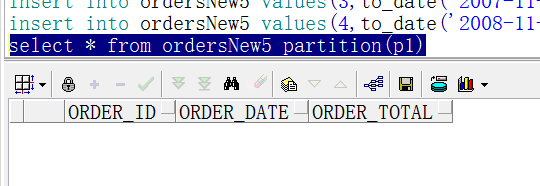首先回顾分区表
表分区
允许将一个表分成多个分区
用户可以执行查询怒,之访问表中特定分区
将不同的分区存储在不同的磁盘。提高访问性能
什么是分区表?
oracle允许用户把一个表中所有行分成区块,被分区的表存储在不同的位置,也就提高了表的性能,被分区的表称为分区表,分区表的每一个部分称为分区
分区表的优点?
改善查询性能,表更容易管理
便于备份和恢复
提高数据安全性
(3)可以将分区映射到不同的物理磁盘上,来分散IO;
分区表的设定原则
数据大于2GB,已有数据和新添加数据有明显的界限划分。
04.分区表的分类
解析:
范围分区
列值的范围作为划分条件
其他分区
虚拟分区
间隔分区
注意:
一般创建表分区时,都会将表分区最后一个分区设置为maxvalue
不发和表里的数据,会放在maxvalue 分区上作为最大值,如果没有插入足够大的分区,插入的数据超出范围就会报错,如果插入的数据书分区上的键值的数据就会落入到下一分区。
--分区表
//创建一个表,表不要单纯的执行
//maxvalue()不属于表分区的数据就放在maxvalue区域,其余低于一定时间的数据就在那个分区下

比如查看分区表的第一分区没有小于2005-01-01的数据就空
create table ordersNew5
(
order_id number(12),--订单编号
order_date date not null,
order_total number(8,2)
)
partition by range(order_date)
(
partition p1 values less than (to_date('2005-01-01','yyyy-mm-dd')),
partition p2 values less than (to_date('2006-01-01','yyyy-mm-dd')),
partition p3 values less than (to_date('2007-01-01','yyyy-mm-dd')),
partition p4 values less than (maxvalue)
)
select * from ordersNews2 partition(p4)
)
insert into ordersNew5 values(3,to_date('2007-11-11','yyyy-mm-dd'),300);
insert into ordersNew5 values(4,to_date('2008-11-11','yyyy-mm-dd'),200);
select * from ordersNew5 partition(p1)
*******************************************************************
struts2
02.Struts 2及其优势
Struts 2是一个MVC框架,以WebWork框架的设计思想为核心,吸收了Struts 1的部分优点
Struts 2拥有更加广阔的前景,自身功能强大,还对其他框架下开发的程序提供很好的兼容性
//预习:如何让一个普通类称为一个Action
// 实现了一个接口 Action 代表Action类配置的时候就能找到
public class HelloAction implements Action{
@Override
//逻辑视图名
public String execute() throws Exception {
return SUCCESS;
}
}
使用Struts 2 开发程序的基本步骤
1、加载Struts2 类库 1.加载Struts2类库 jar
2、配置web.xml文件 配置web.xml (配置拦截器)
3、开发视图层页面
4、开发控制层Action
5、配置struts.xml文件
6、部署、运行项目
步骤1: 配置web.xml文件
<filter>
<filter-name>struts2</filter-name>
<filter-class>org.apache.struts2.dispatcher.ng.filter.StrutsPrepareAndExecuteFilter</filter-class>
</filter>
<filter-mapping>
<filter-name>struts2</filter-name>
<!-- 拦截所有的action -->
<url-pattern>/*</url-pattern>
</filter-mapping>
步骤2:在src下创建名称为struts.xml的配置文件
<?xml version="1.0" encoding="UTF-8" ?>
<!DOCTYPE struts PUBLIC
"-//Apache Software Foundation//DTD Struts Configuration 2.3//EN"
"http://struts.apache.org/dtds/struts-2.3.dtd">
<struts>
<!-- 配置文件中只要添加以下配置,那么以后修改配置文件不用重启tomcat -->
<constant name="struts.devMode" value="true" />
<package name="default" namespace="/" extends="struts-default">
<!-- 第一个action的例子 -->
<action name="helloWorld" class="cn.happy.action.HelloWorldAction">
<result name="success">
index.jsp
</result>
</action>
<!-- 登陆的action -->
</package>
<!-- Add packages here -->
</struts>
步骤3:编写HelloWorldAction
package cn.happy.action;
import com.opensymphony.xwork2.Action;
public class HelloWorldAction implements Action{
private String name ;
private String message;
public String execute() throws Exception {
setMessage("Hello"+getName());
return "success";
}
}
步骤4:创建index.jsp页面
<div>
<h1>
<!--显示Struts Action中message的属性内容-->
<s:property value="message"/>
</h1>
</div>
<div>
<form action="helloWorld.action" method="post">
请输入您的姓名:
<input name="name" type="text" />
<input type="submit" value="提交" />
</form>
</div>
步骤5:通过浏览器访问
点击提交后结果